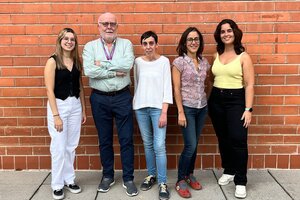A drug capable of simultaneously targeting three different therapeutic targets is designed.
The study, published in the journal Bioorganic Chemistry, presents a proof of concept for this innovative triple-effect compound, which has been successfully applied to breast cancer cells. According to experts, this therapy has "high potential for the treatment of complex diseases such as cancer or diabetes.
The study involves the collaboration of Marçal Pastor-Anglada, head of the Molecular Pharmacology and Experimental Therapies group at IRSJD, researcher Sandra Pérez-Torras, a member of the Molecular Pharmacology and Experimental Therapies research group at IRSJD, professor at the Department of Biochemistry and Molecular Biomedicine at the Faculty of Biology (UB), and researcher at the CIBER for Liver and Digestive Diseases (CIBEREHD), as well as professor Montserrat Terrazas from the Department of Inorganic and Organic Chemistry at the Faculty of Chemistry (UB). The first authors of the scientific paper are postdoctoral researcher Aida Mata-Ventosa and predoctoral researcher Ariadna Vila-Planas.
New strategy against drug resistance
Multifactorial or complex diseases, such as cancer, are the result of the combined action of various factors within the body, which activate multiple tumor signaling pathways. This multiplicity of signals makes cancer cells resistant to certain treatments, as when one drug blocks the main signaling pathway, the tumor's secondary pathways are activated.
"To address these problems, small-molecule drug combinations are often administered, but many of the combined therapies approved so far present various limitations, such as the difficulty of interacting with target proteins that have poorly defined binding sites or toxicity issues due to the interaction between drugs of different chemical natures," explain the scientists.
Faced with this challenge, the researchers developed a pharmacological tool that delivers three antisense oligonucleotide (ASO) drugs. These are short chains of nucleic acids designed to bind to specific messenger RNAs and thus block the key function of this molecule in protein synthesis within cells. This triple pharmacological compound has been successfully applied to breast cancer cells to inhibit the expression of three specific proteins (Akt, Hsp27, and HER2), which contribute to a poor prognosis in breast cancer and resistance to drugs.
The results of the new study show that the toxicity of this therapy on cancer cells is greater than that of the combination of the three ASO drugs administered independently.
"Moreover, the specificity of the selected targets allows the attack on tumor cells that present these alterations without affecting non-tumor cells," the experts add.
The activation of the new combined drug within the cell is facilitated by the enzyme RNase H, which is naturally present in the cellular cytoplasm.
"This enzyme recognizes the central part of the construct (an RNA-DNA hybrid) and cuts the RNA component, which acts as a link between the three drugs. As a result, the three ASO drugs are simultaneously released and can exert their inhibitory functions," the researchers detail.
A promising new tool
The proof of concept has been carried out in cells of a specific type of breast cancer, but the experts suggest that this new tool could be applied in the future to "deliver multiple combinations of ASOs, targeting different combinations of therapeutic targets. This would be useful not only for various types of cancer but also for other complex diseases, such as diabetes," they conclude.
Reference article
Mata-Ventosa, Aida; Vila-Planas, Ariadna; Solsona-Pujol, Aina; de la Dueña, Jordi; Torrents, Maria; Izquierdo-García, Eduardo; Pastor-Anglada, Marçal; Pérez-Torras, Sandra; Terrazas, Montserrat. «RNase H-sensitive multifunctional ASO-based constructs as promising tools for the treatment of multifactorial complex pathologies». Bioorganic Chemistry, Setembre, 2024. DOI: 10.1016/j.bioorg.2024.107595.
Source of information
https://web.ub.edu/en/web/actualitat/w/farmac-actua-contra-tres-dianes-terapeutiques

The specificity of the selected targets allows the attack on tumor cells that present these alterations without affecting non-tumor cells.
